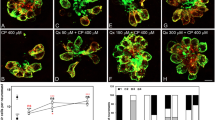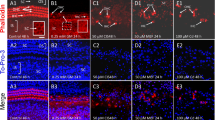Abstract
The present investigation has shown that only metabolized gentamicin (mG) but not native gentamicin (G) is cytotoxic for isolated guinea pig outer hair cells (OHC). Using FURA-2 fluorescence, both G and mG were found to reduce intracellular free Ca2+ concentrations in unstimulated OHC and inhibit increases in intracellular Ca2+ concentrations during K+-induced depolarization. Glutathione-SH (GSH), a detoxificating agent, did not interfere with G and mG effects on intracellular Ca2+ concentration. In non-stimulated OHC, mG but not G induced pathological OHC depolarization, indicating the opening of transduction channels to allow influx of K+ ions. GSH completely inhibited the lytic effect of mG. Electrophysiological investigations also revealed that GSH probably inhibits mG-induced pathological opening of transduction channels. These results suggest that GSH selectively inhibits mG-specific toxic effects on the guinea pig OHC, possibly by enzymatic detoxification.
Similar content being viewed by others
References
Ahokas JT, Davies C, Ravenscroft PJ, Emmerson BT (1984) Inhibition of soluble glutathione S-transferase by diuretic drugs. Biochem Pharmacol 33: 1929–1932
Ashmore JF, Meech RW (1986) Ionic basis of membrane potential in outer hair cells of guinea pig cochlea. Nature 322: 368–371
Beck C, Krahl P (1962) Experimentelle und feingewebliche Untersuchungen über die Ototoxizität von Kanamycin. Arch Otorhinolaryngol 179: 594–610
Brown RD (1973) Cochlear N1 depression produced by the sodium salts of ethacrynic acid and its cysteine adduct. Neuropharmacology 12: 967–974
Brown RD (1975) Comparison of the cochlear toxicity of sodium ethacrynate, furosemide, and the cysteine adduct. Toxicol Appl Pharmacol 31: 270–282
Brummett RE, Brown RT (1979) Quantitative relationships of the ototoxic interaction of kanamycin and ethacrynic acid. Arch Otolaryngol 105: 240–246
Cobbold PH, Rink TH (1987) Fluorescence and bioluminescence measurement of cytoplasmic free calcium. J Biochem 248: 313–328
Crann SA, Huang MY, McLaren JD, Schacht J (1992) Formation of a toxic metabolite from Gentamicin by a hepatic cytosolic fraction. Biochem Pharmacol 43: 1835–1839
Dulon D, Zajic G, Aran JM, Schacht J (1989) Aminoglykoside antibiotics impair calcium entry but not viability and motility in isolated cochlear outer hair cells. J Neurosci Res 24: 338–346
Garetz S, Schacht J (1992) Sulfhydryl compounds reduce gentamicin-induces outer hair cell damage in vitro. Assoc Res Otolaryngol 15: 110
Garetz S, Rhee DJ, Schacht J (1993) Attenuation of gentamicin ototoxicity by glutathione. Assoc Res Otolaryngol 16: 141
Gelboin HV, Friedman FK (1985) Monoclonal antibodies for studies on xenobiotic and endobiotic metabolism. Biochem Pharmacol 34: 2225–2234
Gitter AH, Zenner HP, Frömter E (1985) Ion channels in the cell membrane of guinea pig cochlea outer hair cells. Pflügers Arch 405 [Suppl 1]: R58
Gitter AH, Zenner HP, Frömter E (1986) Membrane potential and ion channels in isolated outer hair cells of guinea pig cochlea. ORL J Otorhinolaryngol Relat Spec 48: 68–75
Grynkiewicz G, Poenie M (1985) A new generation of Ca-indicators with greatly improved fluorescence properties. J Biol Chem 250: 3440–3450
Hawkins JE (1976) Drug ototoxicity. In: Keidel WD, Neff WD (eds) Handbook of sensory physiology Springer, Berlin Heidelberg New York, pp 707–748
Hiel H, Schamel A, Erre JP, Hayashida T, Dulon D, Aran JM (1992) Cellular and subcellular localization of tritiated gentamicin in the guinea pig cochlea following combined treatment with ethacrynic acid. Hear Res 57: 157–165
Hinshaw HC, Feldman WH (1945) Streptomycin in treatment of clinical tuberculosis: a preliminary report. Proc Mayo Clin 20: 313–318
Hoffman DW, Whitworth CA, Jones KL, Rybak LP (1987) Nutritional status, glutathione levels, and ototoxicity of loop diuretics and aminoglycoside antibiotics. Hear Res 31: 217–222
Hoffman DW, Jones-King KL, Whitworth CA, Rybak LP (1988) Potentiation of ototoxicity by glutathione depletion. Ann Otol Rhinol Laryngol 97: 36–41
Hori R, Yamamotoh K, Saito H, Kohno M, Inui K (1984) Effect of aminoglycoside antibiotics on cellular functions of kidney epithelial cell line (LLC-PK1): a model system for aminoglycoside nephrotoxocity. J Pharmacol Exp Ther 230: 742–748
Huang MY, Adock SE (1991) Cytosolic enzymes convert gentamicin to a toxic metabolite. Proc Assoc Res Otolaryngol 14: 73
Huang MY, Schacht J (1989) Drug induced ototoxicity: pathogenesis and prevention. Med Toxicol Adverse Drug Exp 4: 452–467
Huang MY, Schacht J (1990) Formation of a cytotoxic metabolite from Gentamicin by liver. Biochem Pharmacol 40 R11-R14
Hudspeth AJ (1989) How the ear's works work. Nature 341: 397–404
Jaramillo F, Hudspeth AJ (1991) Localization of the hair cells transduction channels at the hair bundles to by iontophoretic application of channel blocker. Neuron 7: 409–442
Keiner S (1992) Hemmung des Glutathions auf die Gentamicin-Wirkung der äuBeren Haarzellen. In: Plinkert P, Giebel W (eds) Klinische Forschung and akademische Mitarbeiter an der Universitätsklinik and Poliklinik fur Hals-Nasen-Ohrenheilkunde Tübingen. University Press, Tübingen, pp 29–30
Keiner S, Zimmermann U (1993) Glutathion hemmt Gentamizinwirkungen an äußeren Haarzellen der Meerschweinchen Cochlea. Eur Arch Otorhinolaryngol Suppl. 11
Keiner S, Zimmermann U, Zenner HP (1994) Fin Antidot gegen die ototoxische Wirkung metabolisierten Gentamicins. HNO (in press)
Kosower NS, Kosower EM (1978) The glutathione status of cells. Int Rev Cytol 54: 109–160
Kroese ABA, Das A, Hudspeth AJ (1989) Blockage of the transduction channels of hair cells in the bullfrog's sacculus by aminoglycoside antibiotics. Hear Res 37: 203–218
Marty A, Neher E (1983) Tight seal whole cell recording. In: Sakmann B, Neher E (eds) Single-channel recordings. Plenum Press, New York, pp 107–122
Meister A, Anderson ME (1983) Glutathione. Annu Rev Biochem 52: 711–760
Nelson SD, Gordon WP (1983) Mammalian drug metabolism. J Nat Prod 46: 71–78
Nilles R (1993) Zur Wirkung von Kalziumkanalblockern im Innenohr. Thesis, University of Tiibingen Medical School
Ohmori H (1988) Mechanical stimulation and FURA-2 fluorescence in the hair bundle of dissociated hair cells of the chick. J Physiol (Lond) 399: 115–137
Olson R, MacDonald J (1980) Regulatory role of glutathione and soluble sulfhydryl groups in the toxicity of Adriamycin. J Pharmacol Exp Ther 215: 450–454
Orsulakova A, Stockhorst E, Schacht J (1976) Effect of neomycin on phosphoinositide labeling and calcium binding in guinea pig inner ear tissues in vivo and in vitro. J Neurochem 26: 285
Pierson M, Møller A (1981) Prophylaxis of kanamycin-induced ototoxicity by a radioprotectant. Hear Res 4: 79–87
Pierson MG, Gray BH (1982) Superoxide dismutase activity in the cochlea. Hear Res 6: 141–151
Prazma J, Garrison HG, Fischer J, Williford SK, Drake A, Ferguson SD, Klingler LE (1983) Alteration of aminoglycoside antibiotic ototoxicity: effect of semistarvation. Ann Otol Rhinol Laryngol 92: 178–182
Rybak LP, Hoffman DW (1987)Glutathione depletion markedly enhances drug-induced hearing loss: possible mechanism of ototoxicity. In: Löbe LP (ed) Proceedings of the VIII International Cochlea-Symposium. University Press, Halle (Saale), pp 54–56
Sande MA, Mandell GL (1985) Antimicrobial agents. The aminoglycosides. In: Goodman AG, Rall TW (eds) The pharmacological basis of therapeutics. Macmillan, New York, pp 1150–1169
Schacht J (1986) Molecular mechanisms of drug-induced hearing loss. Hear Res 22: 297–304
Schacht J, Weiner N (1986) Aminoglycoside-induced hearing loss: a molecular hypothesis. ORL 48: 116
Spoendlin H (1966) Zur Ototoxizitdt des Streptomycins. Pract Otorhinolaryngol 28: 374
Takada A, Schacht J (1982) Calcium antagonism and reversibility of gentamicin-induced loss of cochlear microphonics in the guinea pig. Hear Res 8: 179–186
Waksman SA (1953) Streptomycin: background, isolation, properties, and utilization. Science 118: 259–266
Yamada T, Kaplowitz N (1980) Binding of ethacrynic acid to hepatic glutathione-S-transferase in vivo in the rat. Biochem Pharmacol 29: 1205–1208
Zenner HP, Schacht J (1986)Hörverlust durch Aminoglykosid Antibiotika: Angriff am Membranbaustein PIP2 in äußeren Haarzellen als Wirkungsmechanismus. HNO 34: 417–423
Zenner HP, Gitter AH, Zimmermann U, Schmitt U, Frömter E (1985) Die isolierte Haarzelle. Laryngol Rhinol Otol 64: 642–648
Zimmermann U, Reuter G, Zenner HP (1992) Aminoglycosid-Ototoxizität (abstract). DFG-Meeting Hörforschung
Author information
Authors and Affiliations
Rights and permissions
About this article
Cite this article
Zenner, H.P., Keiner, S. & Zimmermann, U. Specific glutathione-SH inhibition of toxic effects of metabolized gentamicin on isolated guinea pig hair cells. Eur Arch Otorhinolaryngol 251, 84–90 (1994). https://doi.org/10.1007/BF00179898
Received:
Accepted:
Issue Date:
DOI: https://doi.org/10.1007/BF00179898




